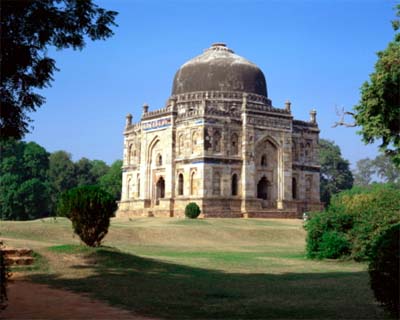Nov 07, 2025
Nov 07, 2025
The sultanate of Delhi survived for more than another century after the last Tughlaq. Two Afghan sultanates, the Sayyids and Lodis tried to restore some respectability and former glory to Delhi. In this attempt the Sayyids (1414-1451) failed and the Lodis (1451-1526) succeeded marginally. Khizr Khan is credited as the founder of the Sayyid dynasty. He was the governor of Multan (in Sindh), who took advantage of a power vacuum in Delhi. He imprisoned the ruler chosen by the nobles of Delhi, one Daulat Khan Lodi but managed to barely hold a shrinking empire together for seven years. After his death in 1421, his son Mubarak Khan held power until 1439, when he too succumbed to internal intrigue and conspiracy. The empire further splintered and the last of the Sayyids, Muhammad (son of Mubarak) abdicated the throne to Bahlul Khan Lodi in the year 1451 and retired.
The Sayyids: Khizr Khan –> Mubarak Khan –> Muhamamd Khan
The Lodi Dynasty
 The Lodi dynasty lasted for seventy-five years. Bahlul Khan Lodi (1451-1489) and his son Sikandar Khan Lodi (1489-1517) managed to regain some of the territory that had been lost by the Sayyids due to inept administration. Sikandar, in 1504 founded a new town on the southern banks of River Jamuna called Agra. A violent earthquake in 1505 shattered buildings and buried thousands alive in Agra. A grand fort had been built in Agra that was in ruins after the earthquake. His nemesis, a raja Mansingh of Gwalior, continued to hold his own and this further weakened the Lodi power, leaving it vulnerable in Panjab for an Afghan ruler named Babur to take advantage of. Before his death in 1517 he built Moth ki Masjid (so called Mosque of Lentil) in Delhi. Legend has it that Sikandar picked up a single lentil and gave it to his minister to be sown, which resulted in bumper crops year after year, thus financing the mosque. The last of the Lodi’s was Ibrahim Khan (1517-1526), who was in a power struggle with his brother as well as the other nobles and ministers. Alam Khan, an uncle and Daulat Khan, the governor of Lahore conspired against him and invited Babur to invade Delhi. Ibrahim Khan Lodi lost his life in the battle of Panipat in 1526 and made way for the Mughal Empire. Lodi rulers had invited a large contingency of Afghan nobles to Delhi, which eventually came back to haunt them and result in the demise of Lodi dynasty. Ibrahim Lodi was unable to effectively control them and they betrayed him in the end.
The Lodi dynasty lasted for seventy-five years. Bahlul Khan Lodi (1451-1489) and his son Sikandar Khan Lodi (1489-1517) managed to regain some of the territory that had been lost by the Sayyids due to inept administration. Sikandar, in 1504 founded a new town on the southern banks of River Jamuna called Agra. A violent earthquake in 1505 shattered buildings and buried thousands alive in Agra. A grand fort had been built in Agra that was in ruins after the earthquake. His nemesis, a raja Mansingh of Gwalior, continued to hold his own and this further weakened the Lodi power, leaving it vulnerable in Panjab for an Afghan ruler named Babur to take advantage of. Before his death in 1517 he built Moth ki Masjid (so called Mosque of Lentil) in Delhi. Legend has it that Sikandar picked up a single lentil and gave it to his minister to be sown, which resulted in bumper crops year after year, thus financing the mosque. The last of the Lodi’s was Ibrahim Khan (1517-1526), who was in a power struggle with his brother as well as the other nobles and ministers. Alam Khan, an uncle and Daulat Khan, the governor of Lahore conspired against him and invited Babur to invade Delhi. Ibrahim Khan Lodi lost his life in the battle of Panipat in 1526 and made way for the Mughal Empire. Lodi rulers had invited a large contingency of Afghan nobles to Delhi, which eventually came back to haunt them and result in the demise of Lodi dynasty. Ibrahim Lodi was unable to effectively control them and they betrayed him in the end.
The Lodis: Bahlul Khan –> Sikandar Khan –> Ibrahim Khan
Muslim immigration to India continued during this period, perhaps at a much faster pace than before. Influence of Delhi as powerhouse waned and several Muslim and non-Muslim states were born. Thus Gujarat was under sultan Ahmad Khan (founder of Ahmadabad), Malwa under Dilwar Khan. Bahmanid kingdom arose in the middle of 14th century ruled by sultans of Afghan descent. They ruled northern Karnataka whereas further south the glorious kingdom of Vijayanagra was born in the 1330’s. Kashmir, Bengal and Rajput states became independent states. The Muslim influence was decentralized until the appearance of the Mongols again. These newcomers were called Mughals and it was they who left a lasting impression on Hindu India. The assimilation of Hindu and Muslim religions progressed at a rapid pace after the establishment of Mughal kingdom by Babur in 1526.
Next: The Mighty Mughals
12-Jun-2002
More by : Dr. Neria H. Hebbar

|
I happened to come across this site and then to articles written by Dr. Neria H. Hebbar on various dynasties in Indian history. To be very frank, I am yet to see more informative, concise, yet very expressive blogs . My sincere complements to Dr. Hebbar on his efforts. Infact I tried to subscribe to his future blogs as well through a link , given on the portal. However I failed, may be because of some technical failure. Nonetheless, enjoyed his blogs thoroughly. |

|
this is a really well written article in simple sophisticated language. |